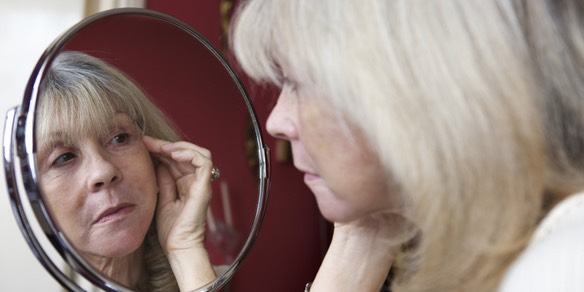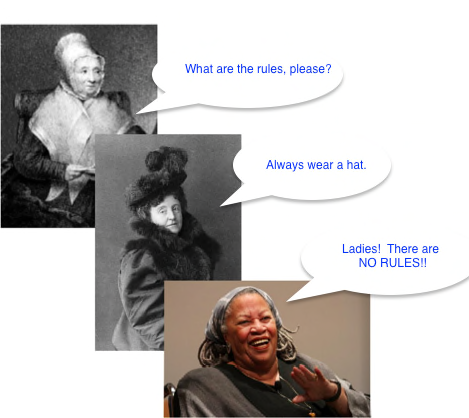How Do I Look?
Ageism and Women’s Author Photos

It’s human nature to look for patterns, reasons, cause and effect. So maybe I was over-reaching when I connected my publisher’s failure to ask me for an author photo with the fact that I’d stopped dyeing my hair? Still, I’d published over ten books by then, and this was the first time a photo wasn’t requested. I loved my new silver locks, but maybe what some people had warned me would happen if I didn’t “fight” age, had caught me unawares—I’d become invisible, at least on the covers of my books!
Armed with steely (pun intended) determination and some dear, cooperative friends who work in bookstores and libraries, I decided to find out if I was the only one, or if other “women authors of a certain age” were experiencing a similar invisibility. Most of my novels have been published as Young Adult titles, so I decided to start there: I sent out an email to folks who sold or lent titles for YA readers, and I got some disappointing confirmation: the manager of one of the largest chain of independent bookstores in the country wrote that, since their stores carry thousands of titles, she could only guestimate on numbers, but what she did notice was that, “There seem to be more older "white/gray"-haired men on the YA flaps than older "white/gray"-haired women; and many more younger females than both.”
Oh, oh. And it only got worse: the manager of children’s books in my own favorite local store, was able to do an exact tally of her new titles. She found that more than half included author photos on the jacket, but only a single one featured a writer with gray or white hair. And guess what? He was a man. She wrote me that, “None of these numbers surprised me in the least. From my experience as a buyer, all energy and marketing tends towards young women and men.” Her count matched that of a school librarian who reported that of her thirteen new YA titles with author photos, only two featured folks with gray hair —and they were both nationally renowned "rock star" writers.
I’m blessed to be in a book club that is comprised almost entirely of authors and librarians, so my next step was to visit the largest regional library in my area. Here, the YA Librarian, who also hosts our club, let me personally inspect every one of her 150 brand new YA titles. My own up close and personal survey revealed that 79 of these books featured no author photos at all. Two included a cartoon of the (female) authors, and one featured a photo of birds in flight, not the female author.
In terms of faceless casualties, the numbers were proportional: 119 of the new books were written by women and 31 by men, with 65 of the women’s books (about 55 percent) missing photos, and 17 (about 54 percent) of the male-authored titles missing them. Pretty even-Stephanie, right?
But let’s look at what’s left: of the 14 male author photos, half were (or appeared to be) of men 40 years old or more. But of the 54 female author pics, 10 (a little less than 20 percent) may have been over 40, while one (a celebrity author) was over 60. Of these, only a single brave heart sported gray hair. (I actually squealed with relief when I came on her picture, no doubt bolstering the conviction of the young patrons in the YA wing that old folks are nuts.) And the rest of the women authors pictured? They were 20-to-30 something’s, some with tattoos, others with sweet, haunted eyes. All 43 of them unquestionably young, young, young.
Why? Is this ageism (which extends to promotion and marketing, panels and conference invitations, school visits, and yes, book advances) due to an editorial assumption that teens require storytellers to be close to their own age? (Most of the books on these shelves were fantasy, so “hip” would hardly seem to be a pe-requisite.) I know some houses have simply done away with author photos as a general rule. (I was actually thrilled when McElderry put a poem, instead of a photo or blurbs, on the back cover of my new novel.) But aren’t YA readers still as curious as I was growing up, to see what the author looks like? Would it really assault their aesthetic to find a white-haired bard on the back flap?
Or is it worse than this? Is there a culture-wide aversion involved here? In The Denial of Death, cultural anthropolosist Ernest Becker suggests that to keep the awareness of certain death at bay, societies across the globe develop ways of managing our terror by treating old folks differently —either isolating them or venerating them. Guess which way contemporay eastern cultures have gone? So much so, that one agent suggests publishing houses don’t want to take on older authors—Jamie Cowan, the Director of the Ampersand Literary agency in England, suggests there’s an almost mathematical insurance scheme involved: “ When publishers are looking to launch a nw book, they want to appeal to the biggest audience possible. Social media comes into this, but they also want longevity. They want someone they can get several books out of, and a lot of the time it’s going to be younger authors who tick these boxes.”
Ouch! So not only do we need to look younger; we need to live longer! But what can we do? As older women authors for young readers, we’ve got two strikes against us: we’re female and we’re aging. Is it any wonder that poet and children’s writer, Marie Myung-Ok Lee, wrote a 2016 article in The Millions titled “Occupy Author Photo,” in which she advocates using a drawing or sketch instead of a photo, or better and braver yet, opting out entirely?
But would this be fair to readers who are curious about the person behind the book that’s held them spell-bound for the last two or three days? And doesn’t it pander to the worst sort of ageism by sweeping gray hair and wrinkles, not only under the rug, but out of the realms of art and intergenerational dialogue?
So let’s brainstorm, let’s work on ways to remind all of us, editors and agents and readers of all ages, that no older person is like any other, just as no book is. That gray-haired women can be as “distinguished” as gray-haired men. Isn’t it time to move past the era when female authors were rare, genteel birds, to a time when we can all laugh with relief that we’ve reclaimed such valuable, beautiful women as active players in our literary life.

Hannah Adams, top, was the first female author published in the U.S. Recognize Frances Hodgson Burnett, author of The Secret Garden, in the middle picture? And of course, that’s Toni Morrison, the gobally Beloved (pun intended) author, laughing in the bottom photo.
* Want a take on author photos from the point of view of a transgender writer? See: “For and Against Author Photos" by poet Stephen Burt.
